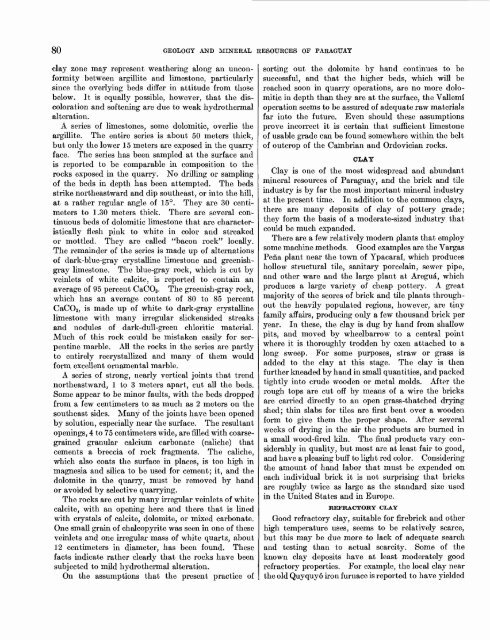Geology and Mineral Resources of Paraguay A Reconnaissance
Geology and Mineral Resources of Paraguay A Reconnaissance
Geology and Mineral Resources of Paraguay A Reconnaissance
- No tags were found...
Create successful ePaper yourself
Turn your PDF publications into a flip-book with our unique Google optimized e-Paper software.
80 GEOLOGY AND MINERAL RESOURCES OF PARAGUAYclay zone may represent weathering along an unconformitybetween argillite <strong>and</strong> limestone, particularlysince the overlying beds differ in attitude from thosebelow. It is equally possible, however, that the discoloration<strong>and</strong> s<strong>of</strong>tening are due to weak hydrothermalalteration.A series <strong>of</strong> limestones, some dolomitic, overlie theargillite. The entire series is about 50 meters thick,but only the lower 15 meters are exposed in the quarryface. The series has been sampled at the surface <strong>and</strong>is reported to be comparable in composition to therocks exposed in the quarry. No drilling or sampling<strong>of</strong> the beds in depth has been attempted. The bedsstrike northeastward <strong>and</strong> dip southeast, or into the hill,at a rather regular angle <strong>of</strong> 15°. They are 30 centimeters to 1.30 meters thick. There are several continuousbeds <strong>of</strong> dolomitic limestone that are characteristicallyflesh pink to white in color <strong>and</strong> streakedor mottled. They are called "bacon rock" locally.The remainder <strong>of</strong> the series is made up <strong>of</strong> alternations<strong>of</strong> dark-blue-gray crystalline limestone <strong>and</strong> greenish-gray limestone. The blue-gray rock, which is cut byveinlets <strong>of</strong> white calcite, is reported to contain anaverage <strong>of</strong> 95 percent CaCO3 . The greenish-gray rock,which has an average content <strong>of</strong> 80 to 85 percentCaCO3 , is made up <strong>of</strong> white to dark-gray crystallinelimestone with many irregular slickensided streaks<strong>and</strong> nodules <strong>of</strong> dark-dull-green chloritic material.Much <strong>of</strong> this rock could be mistaken easily for serpentine marble. All the rocks in the series are partlyto entirely recrystallized <strong>and</strong> many <strong>of</strong> them wouldform excellent ornamental marble.A series <strong>of</strong> strong, nearly vertical joints that trendnortheastward, 1 to 3 meters apart, cut all the beds.Some appear to be minor faults, with the beds droppedfrom a few centimeters to as much as 2 meters on thesoutheast sides. Many <strong>of</strong> the joints have been openedby solution, especially near the surface. The resultantopenings, 4 to 75 centimeters wide, are filled with coarsegrainedgranular calcium carbonate (caliche) thatcements a breccia <strong>of</strong> rock fragments. The caliche,which also coats the surface in places, is too high inmagnesia <strong>and</strong> silica to be used for cement; it, <strong>and</strong> thedolomite in the quarry, must be removed by h<strong>and</strong>or avoided by selective quarrying.The rocks are cut by many irregular veinlets <strong>of</strong> whitecalcite, with an opening here <strong>and</strong> there that is linedwith crystals <strong>of</strong> calcite, dolomite, or mixed carbonate.One small grain <strong>of</strong> chalcopyrite was seen in one <strong>of</strong> theseveinlets <strong>and</strong> one irregular mass <strong>of</strong> white quartz, about12 centimeters in diameter, has been found. Thesefacts indicate rather clearly that the rocks have beensubjected to mild hydrothermal alteration.On the assumptions that the present practice <strong>of</strong>sorting out the dolomite by h<strong>and</strong> continues to besuccessful, <strong>and</strong> that the higher beds, which will bereached soon in quarry operations, are no more dolomiticin depth than they are at the surface, the Vallemioperation seems to be assured <strong>of</strong> adequate raw materialsfar into the future. Even should these assumptionsprove incorrect it is certain that sufficient limestone<strong>of</strong> usable grade can be found somewhere within the belt<strong>of</strong> outcrop <strong>of</strong> the Cambrian <strong>and</strong> Ordovician rocks.CLAYClay is one <strong>of</strong> the most widespread <strong>and</strong> abundantmineral resources <strong>of</strong> <strong>Paraguay</strong>, <strong>and</strong> the brick <strong>and</strong> tileindustry is by far the most important mineral industryat the present time. In addition to the common clays,there are many deposits <strong>of</strong> clay <strong>of</strong> pottery grade;they form the basis <strong>of</strong> a moderate-sized industry thatcould be much exp<strong>and</strong>ed.There are a few relatively modern plants that employsome machine methods. Good examples are the VargasPefia plant near the town <strong>of</strong> Ypacarai, which produceshollow structural tile, sanitary porcelain, sewer pipe,<strong>and</strong> other ware <strong>and</strong> the large plant at Aregua, whichproduces a large variety <strong>of</strong> cheap pottery. A greatmajority <strong>of</strong> the scores <strong>of</strong> brick <strong>and</strong> tile plants throughoutthe heavily populated regions, however, are tinyfamily affairs, producing only a few thous<strong>and</strong> brick peryear. In these, the clay is dug by h<strong>and</strong> from shallowpits, <strong>and</strong> moved by wheelbarrow to a central pointwhere it is thoroughly trodden by oxen attached to along sweep. For some purposes, straw or grass isadded to the clay at this stage. The clay is thenfurther kneaded by h<strong>and</strong> in small quantities, <strong>and</strong> packedtightly into crude wooden or metal molds. After therough tops are cut <strong>of</strong>f by means <strong>of</strong> a wire the bricksare carried directly to an open grass-thatched dryingshed; thin slabs for tiles are first bent over a woodenform to give them the proper shape. After severalweeks <strong>of</strong> drying in the air the products are burned ina small wood-fired kiln. The final products vary considerablyin quality, but most are at least fair to good,<strong>and</strong> have a pleasing buff to light red color. Consideringthe amount <strong>of</strong> h<strong>and</strong> labor that must be expended oneach individual brick it is not surprising that bricksare roughly twice as large as the st<strong>and</strong>ard size usedin the United States <strong>and</strong> in Europe.REFRACTORY CLAYGood refractory clay, suitable for firebrick <strong>and</strong> otherhigh temperature uses, seems to be relatively scarce,but this may be due more to lack <strong>of</strong> adequate search<strong>and</strong> testing than to actual scarcity. Some <strong>of</strong> theknown clay deposits have at least moderately goodrefractory properties. For example, the local clay nearthe old Quyquy6 iron furnace is reported to have yielded
















